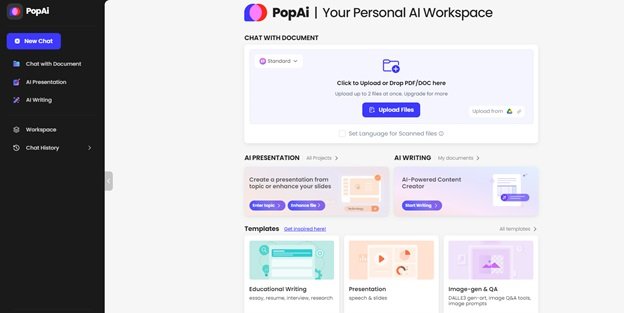The rise of artificial intelligence (AI) has transformed many industries, including content creation for blogging. AI tools can churn out blog posts at speeds unmatched by humans. However, human-written content brings authenticity and original perspectives.
As a blogger, understanding the strengths and limitations of both is key to leveraging them effectively. In this article, we’ll mention the key differences between AI and human-written content to help you with your content generation strategy.
AI vs. Human Content: A Comparison
When deciding between AI or human-generated content, compare them across factors like:
Content Creation Speed
AI tools can research a topic and write complete blog posts in seconds, while a human would take hours or days to write the same word count. Tools like PopAi provide fully written drafts almost instantly once given a topic and keywords. This enables high-volume, rapid content production.

However, humans still reign over creating truly original analysis and commentary based on experience and creative thinking. AI lacks human judgment to connect ideas in an inspired way tailored for a blog’s niche audience. Yet if a blogger’s goal is to quickly generate foundational content as a starting point, AI accelerates the process.
Fact-Checking
Most AI writing tools draw text from existing online sources. This risks inaccurately representing or repeating incorrect information without additional verification. As of 2024, no AI can match a knowledgeable human’s discernment to distill accurate facts from misinformation when writing blog posts.
Humans excel at analyzing source credibility, discerning subtleties, and fact-checking details while writing. They can also provide expert informed perspectives to blog content. However, pure AI tools should not be solely relied on where meticulous factual correctness matters most.
Originality and Authenticity
AI tools including market leaders like Jasper mix and match phrasing from sites like Wikipedia to develop blog drafts. While this works for basic articles, it lacks originality. Blog readers crave uniqueness and insider expertise, not repackaged content.
Alternatively, nothing surpasses a human blogger’s first-hand experience to inject authentic personalized perspectives. Expressing passion, humor, or vulnerability through storytelling hooks readers better than AI’s emotionally-void text. Human creativity and voice are virtually impossible for AI to replicate genuinely.
Word Count
In a matter of seconds, AI creator platforms can spew out upwards of 1,000 computer-generated words on almost any topic with coherent paragraph structure. Without needing to research or carefully think through ideas, high word counts come easy to AI.
Humans with in-depth knowledge can also produce long posts; it just demands far more effort and time. However, higher word counts do not always produce superior content if not purposefully crafted. Humans are better judges of what level of consciousness or length best suits different blogging objectives. Less can often be more regarding capturing reader attention.
Structure
For a basic blog post, AI composes readable content with an introduction, body paragraphs elaborating on the subject, and a conclusion. This standardized structure aids rapid output, although it risks being overly formulaic.
Humans actively organize sections in a logical flow best serving post goals and audience needs. While human writing takes more forethought, headings, selective highlights, visuals, and balanced white space can enhance content presentation too. So humans edge over AI regarding deliberately structuring posts for maximized impact.
AI Written Content: Pros and Cons
The biggest advantage of AI-written content is the incredible output speed at scale. Bloggers can produce thousands of words per day on almost any topic thanks to AI tools that synthesize information rapidly into blog post drafts.
This volume capacity enables mass content production at a fraction of the cost of human writing. AI writing also conveniently optimizes posts to target specific keywords.
However, AI falls short regarding originality and injecting authentic personality into text. Often the writing seems bland or generically formulated. Quality control is also hit or miss; some paragraphs read smoothly while others need heavy editing.
Another common downside is factual inaccuracies and questionable sources since the AI merely pulls and rewrites data from elsewhere online. Without real expertise or firsthand experience, AI cannot adequately educate readers seeking niche insights.
Human Written Content: Pros and Cons
In contrast to AI’s limitations, human written blog content brings irreplaceable strengths through authors’ authentic voice and creativity. Drawing on many years building knowledge and skills within a field, a human blogger provides expert perspectives unavailable through AI tools alone. This breeds reader trust and interest. Humans also take accountability for error-free factual correctness stemming from reliable sources.
With creativity and strategic consideration, human writers develop content deliberately tailored to serve the niche readers they understand best. However, generating high volumes of such purposeful articles demands far more time and financial resources than AI.
The writing and editing process for thoughtful engagement is slow, making it challenging to scale. And when aiming to educate rather than simply entertain with generic content, optimizing strictly for keyword density can detract from quality.
Conclusion
Both AI and human writing skills make valuable contributions based on a blogger’s niche, business model and content purposes. Neither can fully replace the other regarding optimizing engagement.
AI delivers unmatched efficiency for bloggers prioritizing search engine visibility through volumes of keyword-rich content. Its continual improvement at mimicking human-level writing shows promise over the next decade too.
Yet the irreplaceable thought leadership, trust-building and creative finesse only possible through human blogging will retain reader appeal long-term. The wise blogger leverages both man and machine symbiotically. Each excels where the other falls short. Combining AI’s scalability with humans’ ingenuity and connection offers the best path to grow a thriving blog that stands out.
